|
|
|
Sort Order |
|
|
|
Items / Page
|
|
|
|
|
|
|
| Srl | Item |
| 1 |
ID:
168970
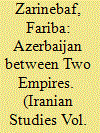

|
|
|
|
|
| Summary/Abstract |
The first part of the paper examines the evolution and transformation of Safavid ideology in the context of confessional changes and the role of Turkoman tribes in the Safavid social movement in the Ottoman‒Iranian borderland. The second part examines the impact of Ottoman‒Safavid wars and religious rivalry on the society and economy of Azerbaijan from the sixteenth to the eighteenth centuries.
|
|
|
|
|
|
|
|
|
|
|
|
|
|
|
|
| 2 |
ID:
168969
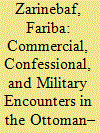

|
|
|
| 3 |
ID:
168979


|
|
|
|
|
| Summary/Abstract |
Among the Achaemenid inscriptions, DPg has been the topic of several studies since the very beginning of cuneiform studies. The photographs prepared by the DARIOSH (Digital Achaemenid Royal Inscription Open Schema Hypertext) project at L’Orientale University of Naples shed light on some ambiguities of this specific inscription and led to the proposal of a new text edition of DPg. The purpose of this article is to follow the whole history of studies on DPg until today and then propose a new reading of the inscription and a discussion of related issues, including its unique creation formula and orthography.
|
|
|
|
|
|
|
|
|
|
|
|
|
|
|
|
| 4 |
ID:
168978


|
|
|
|
|
| Summary/Abstract |
Located in the Caspian forest south of the capital city of Sāri in Mazandaran, the rural district of Kalijān Rostāq is home to a number of close-knit villages which share a local Mazandarani dialect. The vernacular offers some authentic features in phonology, morphology, and lexis that are otherwise lost in the urban variety spoken in Sāri due to contact with Persian. In an attempt to elucidate on the loosely-known aspects of the Mazandarani language, this study offers a sketch grammar of the dialect of Kalijān Rostāq with a view to typological features. The glossary that follows includes many Caspian cultural items that are already moribund in the language.
|
|
|
|
|
|
|
|
|
|
|
|
|
|
|
|
| 5 |
ID:
168971


|
|
|
|
|
| Summary/Abstract |
The article aims to refute a long-standing thesis first put forth by Vladimir Minorsky about how the various copies of the dīvān of Shah Ismāʿīl might reflect shifts and changes in the religious and political landscape of early modern Iran. Contrary to the luminary Russian Orientalist’s claims, it demonstrates and contextualizes the observation that there were several textual traditions and that most of the copies continued to reflect messianism and “extremist” notions of religiosity well into late Ṣafavid times, appealing to a broad audience which was likely made up of Sufi adepts and nomadic Qizilbash, as well as a more refined echelon of courtly connoisseurs, residing in the borderland between the Ottoman lands and Iran. At the same time, it suggests that the main theme of Shah Ismāʿīl’s messianic poetry was sainthood and that in this sense Ṣafavid messianism was not a unique aberration but comparable and connected to such similar ideologies as are known from the Timurid, Ottoman or Mughal context.
|
|
|
|
|
|
|
|
|
|
|
|
|
|
|
|
| 6 |
ID:
168980


|
|
|
|
|
| Summary/Abstract |
The June 1941 German invasion of the Soviet Union unleashed a series of events that culminated in the Allied invasion of Iran two months later. In their propaganda, Britain and the Soviet Union publicly justified that invasion as a means of preventing Iran from falling into the German orbit. However, a review of radio broadcasts of the time shows the theme of a German menace was not widely believed in the region. Using BBC Summary of World Broadcasts transcripts from the period, this paper argues that the decision to base their propaganda on a lie also negatively affected relations in the postwar world. In that sense the decision to justify the invasion on the basis of German presence was a propaganda failure for the allies.
|
|
|
|
|
|
|
|
|
|
|
|
|
|
|
|
| 7 |
ID:
168977
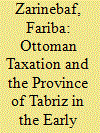

|
|
|
| 8 |
ID:
168973
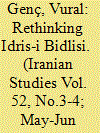

|
|
|
|
|
| Summary/Abstract |
A bureaucrat and historian of Iranian origin, Idris-i Bidlisi (b. Ray/Iran 1457–d. Istanbul 1520), is undoubtedly one of the most original and important intellectual figures in the Ottoman‒Iranian borderland in the sixteenth century. He lived in a very turbulent period and established different relationships with Iranian and Ottoman dynasties at the end of the fifteenth century and at the beginning of the sixteenth century. He and his works have been the focus of long-standing historical debates in Turkey that have continued to the present day. Until now, most modern scholarly works on Bidlisi have failed to provide a proper, in-depth textual and historical analysis. As a result, such modern works have come to present a skewed, romanticized image of Bidlisi, largely detached from the nature and dynamics of the historical context in which Bidlisi lived and evolved as an intellectual and writer. This paper provides a realistic appraisal of Bidlisi and discusses the shortcomings of modern historiography on him. By looking at Bidlisi and his corpus, and more specifically at the ways in which the latter was shaped by Bidlisi’s patronage relationships, the paper aims to open up a window into Bidlisi’s evolving mindset and worldview. In other words, through an in-depth analysis of his corpus and new archival sources the paper strives to unveil the intellectual life and career of an Iranian bureaucrat and historian positioned between Ottoman‒Iranian borderland and provide a glimpse into the nature of patronage in the sixteenth century.
|
|
|
|
|
|
|
|
|
|
|
|
|
|
|
|
| 9 |
ID:
168976
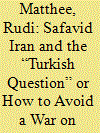

|
|
|
|
|
| Summary/Abstract |
This essay parts with the compartmentalized way in which scholarship tends to view Iran’s military predicament in the Safavid era by examining the perennial threat the Ottomans posed to the country largely in isolation from the recurring conflict between the Safavids and their other main adversaries, the Mughals and Uzbeks, respectively. The security dilemma facing Safavid Iran, it is argued here, was acute as well as multifaceted, and should be approached as such. All three of its direct neighbors were Sunni and two, the Ottomans and the Mughals, were capable of mobilizing far greater military resources than Iran. The main strategic concern of the Safavids was to prevent these neighbors from joining forces and engaging them in a two-front war. This study examines balancing the strategies employed by the three most consequential Safavid shahs, Esma‘il I (1501‒24), Tahmasb (1524‒76), and ‘Abbas I (1587‒1629), to avoid becoming the target of a simultaneous or combined assault by their neighbors. This analysis provides the backdrop to the rational decision the Safavids made in 1639—to end the threat of a two-front war by concluding a lasting peace accord with their most formidable enemies, the Ottomans.
|
|
|
|
|
|
|
|
|
|
|
|
|
|
|
|
| 10 |
ID:
168974
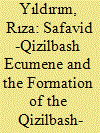

|
|
|
|
|
| Summary/Abstract |
Alevis, the largest religious minority of Turkey, also living in Europe and the Balkans, are distinguished from both Sunnis and Shiʿites by their latitudinarian attitude toward Islamic Law. Conceptualizing this feature as “heterodoxy,” earlier Turkish scholarship sought the roots of Alevi religiosity in Turkish traditions which traced back to Central Asia, on the one hand, and in medieval Anatolian Sufi orders such as the Yasawi, Bektashi, Qalandari, and Wafaʾi, on the other. A new line of scholarship has critiqued the earlier conceptualization of Alevis as “heterodox” as well as the assumption of Central Asian connections. In the meantime, the new scholarship too has focused on medieval Anatolian Sufi orders, especially the Bektashi and Wafaʾi, as the fountainhead of Alevi tradition. Critically engaging with both scholarships, this paper argues that it was the Safavid-Qizilbash movement in Anatolia, Azerbaijan, and Iran rather than medieval Sufi orders, that gave birth to Alevi religiosity.
|
|
|
|
|
|
|
|
|
|
|
|
|
|
|
|
| 11 |
ID:
168975
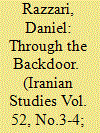

|
|
|
|
|
| Summary/Abstract |
In 1616, the English East India Company expanded its trade into Safavid Iran. The chief merchants in India hoped to acquire a significant share of the Iranian silk trade. After several difficult years in India, the English traders in Surat felt pressure to establish a solid foundation in Iran where they could redirect Iranian silk through Iran’s southern ports and onto Company ships for Europe. Despite Robert Sherley’s promise of wealth and a prosperous market for English cloth, many in the English camp, predominantly Sir Thomas Roe, objected to the silk trade on grounds that it was generally a risky venture. But several leading merchants dismissed Roe’s concerns and pursued the trade without his approval. After early indications that the venture had potential for success, the English silk trade quickly began to falter and finally ceased to exist by 1640. Although its demise was once described as the Company’s failure to produce a substantial quantity of purchasing power—eastern goods, precious metals, and English commodities—this paper explores an alternative explanation that suggests the Company’s failure in Iran was not exclusively the consequence of poor economics.
|
|
|
|
|
|
|
|
|
|
|
|
|
|
|
|
| 12 |
ID:
168972


|
|
|
|
|
| Summary/Abstract |
Beginning with their first confrontation in 1514, the Ottomans and the dynasties ruling over Iran fought over the borderlands extending from the Persian Gulf to Mount Ararat. The transformation of this indeterminate borderland into a clearly defined and increasingly monitored border took almost four centuries. It became an internationally recognized border only after seven decades (1843–1914) of intermittent work by mixed international commissions. Despite such a tangled history, a well-entrenched tradition of Middle Eastern history suggests that the Iranian–Ottoman frontier was firmly established by the Qasr-i Shirin/Zohab Treaty of 1639; and it is one of the oldest boundaries of the world. The myth of 1639 is powerfully enshrined in the historiographies and nationalisms of the countries sharing this boundary. Questioning this myth in the light of Ottoman–Iranian relations, this paper analyzes different versions of 1639 Treaty that were brought to boundary negotiations and exist in various chronicles, and suggests an alternative reading of this foundational myth.
|
|
|
|
|
|
|
|
|
|
|
|
|
|
|
|
|
|
|
|
|